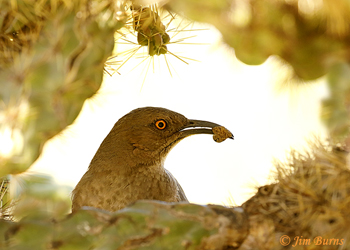Cactus Wren with moth for nestlings |
Curve-billed Thrasher with moth for nestlings |
Surely one of the most overworked words in the English language since the pandemic began is “normal.” Personally 2020 was the most aberrant year of my long and lucky life, and I doubt any of us will ever see our “old normal” again. Irrespective of Covid-19 though, 2020 was abnormal for Arizona birds and birders as well. In the midst of an historic drought we suffered through a “nonsoon” summer which impacted not only our late summer breeders such as Montezuma Quail and grassland sparrows but also our “first summer” breeders of 2021 that depend on insect populations to trigger and sustain April and May nesting.
Though a single wetter-than-average monsoon season will not bring us out of drought conditions it feels so . . . well, wonderful. Though the myriad strange weather events global warming has brought us preclude any expectations about the 2022 monsoon season, this one feels so . . . alright, normal.
I’m sure our common desert avian residents are feeling it too. Curve-billed Thrashers and Cactus Wrens are both known to produce three broods in wet years, and I have personally tracked several thrasher pairs through two broods several times. Though there are a few of our Arizona breeders about which little is known of their phenology, we have as many as 75 species that have been documented raising at least two broods. This large number is due to the length of the state’s breeding season--Arizona is a warm weather state.
This monsoon season Arizona is also a very wet state. It is raining again today as I write this column. When I opened the front door this morning to retrieve the newspaper, moths attracted to our front porch light scattered in all directions. Moths are everywhere right now, and moths are protein. Moths were the most common item brought by both the wrens and the thrashers I observed nesting earlier this week. It is likely there is much more protein out in the desert right now than there was during the spring. It is possible the nesting wrens and thrashers I encountered this week didn’t even bother, or lacked the hormonal urge, to nest during our first summer.
Whatever that case may be, I’m embracing this monsoon season like never before, risking flash floods, chiggers, and mosquitoes to investigate how second summer nesting season is going for our birds, and I want to find out what other amazing critters I’ve been missing for the past several drought ridden summers. It all feels so . . . normal.

